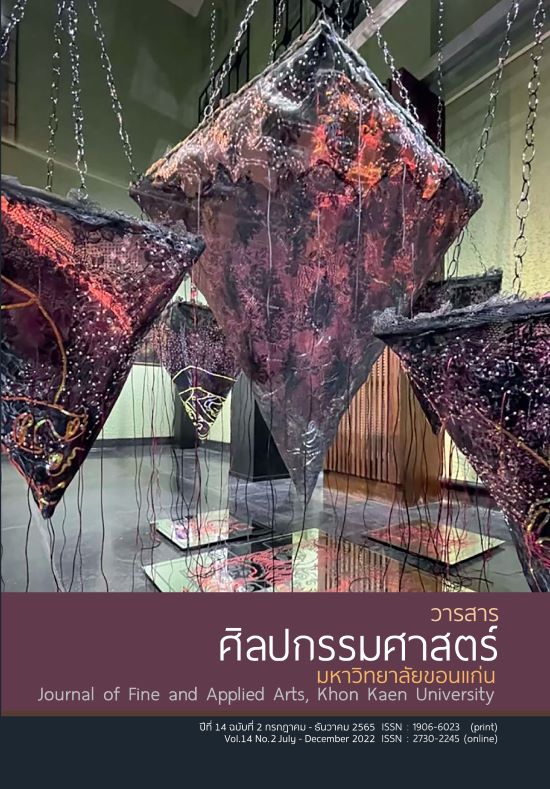คุณลักษณะสำคัญและความเป็นครูต้นแบบของครูเชวงศักดิ์ โพธิสมบัติ
Main Article Content
บทคัดย่อ
การวิจัยครั้งนี้มีวัตถุประสงค์เพื่อศึกษาคุณลักษณะสำคัญและความเป็นครูต้นแบบของครูเชวงศักดิ์ โพธิสมบัติใช้ระเบียบวิธีการวิจัยเชิงคุณภาพ (Qualitative research) วิธีดำเนินการวิจัยเริ่มจากกำหนดผู้ให้ข้อมูลและแหล่งข้อมูล ได้แก่ 1) แหล่งข้อมูลด้านเอกสาร 2) แหล่งข้อมูลด้านบุคคล ใช้การเลือกแบบเจาะจง (Purposive sampling) และการสุ่มตัวอย่างแบบสโนว์บอล (Snowball sampling) เครื่องมือที่ใช้ในการวิจัย ได้แก่ 1) แบบวิเคราะห์เอกสารและสื่ออิเล็กทรอนิกส์ 2) แบบสัมภาษณ์ชนิดกึ่งมีโครงสร้าง (Semi-structural interview) และ 3) แบบสังเกต (Observation form) เก็บข้อมูลภาคสนามด้วยวิธีสังเกตแบบมีส่วนร่วม (Participant observation) ร่วมกับการสัมภาษณ์แบบไม่เป็นทางการ (Informal interview) วิเคราะห์ข้อมูล สร้างข้อสรุปแบบอุปนัย (Induction) และตรวจสอบข้อมูลแบบสามเส้า (Data triangulation)
ผลการวิจัยพบว่า คุณลักษณะสำคัญและความเป็นครูต้นแบบของครูเชวงศักดิ์ โพธิสมบัติประกอบไปด้วย 4 ด้าน ได้แก่ 1) ดนตรีรู้รอบ ทั้งภาคทฤษฎีและสามารถปฏิบัติได้อย่างชำนาญจนได้รับการยอมรับจากบุคคลและสถาบันการศึกษาต่าง ๆ ในวงวิชาชีพและวิชาการดนตรีไทยอย่างกว้างขวาง 2) เก่งมอบความรู้ เริ่มตั้งแต่กระบวนการวิเคราะห์ผู้เรียน มีกลวิธีสำคัญในการถ่ายทอด และการวัดประเมินผลตามสภาพจริง 3) เคียงคู่เมตตา กับลูกศิษย์ทุกรุ่น ให้ความรู้โดยไม่ปิดบัง อีกทั้งยังดูแลเสมือนลูกและห่วงใยเหมือนคนในครอบครัวจนเป็นที่รักและศรัทธาของบรรดาลูกศิษย์ และ 4) นำพาศิษย์ได้ดี เป็นต้นแบบให้กับศิษย์ทั้งในด้านการมีบุคลิกภาพและอัธยาศัยที่ดี การทำงานอย่างมีระบบ ด้านความรู้ความสามารถ การปรับตัวให้เข้ากับผู้เรียน และความกตัญญู
Article Details

อนุญาตภายใต้เงื่อนไข Creative Commons Attribution-NonCommercial-NoDerivatives 4.0 International License.
เนื้อหาและข้อมูลในบทความที่ลงตีพิมพ์ในวารสารคณะศิลปกรรมศาสตร์ มหาวิทยาลัยขอนแก่น ถือเป็นความคิดเห็นและความรับผิดชอบของผู้เขียนบทความโดยตรง ซึ่งกองบรรณาธิการไม่จำเป็นต้องเห็นด้วย หรือร่วมรับผิดชอบใด ๆ
บทความ ข้อมูล เนื้อหา รูปภาพ ฯลฯ ที่ได้รับการตีพิมพ์ในวารสารคณะศิลปกรรมศาสตร์ มหาวิทยาลัยขอนแก่น ถือเป็นลิขสิทธิ์ของวารสารคณะศิลปกรรมศาสตร์ มหาวิทยาลัยขอนแก่น หากบุคคลหรือหน่วยงานใดต้องการนำทั้งหมดหรือส่วนหนึ่งส่วนใดไปเผยแพร่ต่อหรือเพื่อกระทำการใด ๆ จะต้องได้รับอนุญาตเป็นลายลักอักษรจากวารสารคณะศิลปกรรมศาสตร์ มหาวิทยาลัยขอนแก่น ก่อนเท่านั้น
เอกสารอ้างอิง
กรมศิลปากร. (2545). คำบรรยายวิชา ดุริยางคศาสตร์ไทย. กรุงเทพฯ : ชวนพิมพ์.
เจษฎาวัลย์ ปลงใจ. (2561). จริยธรรมกับความเป็นครู. วารสารบัณฑิตศึกษาปริทรรศน์ มจร วิทยาเขตแพร่, 4(1), 113-123.
ทิศนา แขมมณี. (2561). ศาสตร์การสอน องค์ความรู้เพื่อการจัดกระบวนการเรียนรู้ที่มีประสิทธิภาพ. กรุงเทพฯ : โรงพิมพ์แห่งจุฬาลงกรณ์มหาวิทยาลัย.
นิทรา ฉิ่นไพศาล, และพระครูสุจิตรัตนากร. (2559). คุณธรรมความเป็นครู. วารสารครุศาสตร์ปริทรรศน์ฯ, 3(1), 142-155.
พรปวีณ์ จันทร์ผ่อง, และดนีญา อุทัยสุข. (2562). กรอบมโนทัศน์ เรื่อง การใช้หลักความเมตตาในการสอนดนตรีไทยของผู้ช่วยศาสตราจารย์สงบศึก ธรรมวิหาร. วารสารอิเล็กทรอนิกส์ Veridian มหาวิทยาลัยศิลปากร (มนุษยศาสตร์สังคมศาสตร์และศิลปะ), 12(6), 1487-1506.
ยุทธนา ฉัพพรรณรัตน์. (2561). ดนตรีไทยศึกษา. กรุงเทพฯ : โรงพิมพ์แห่งจุฬาลงกรณ์มหาวิทยาลัย.
ราชบัณฑิตยสถาน. (2554). พจนานุกรมฉบับราชบัณฑิตยสถาน พ.ศ. 2554. ค้นเมื่อ 18 พฤษภาคม 2564, จาก https://dictionary.orst.go.th/
วราภรณ์ เชิดชู. (2548). การศึกษาเพลงทยอยเดี่ยวสำหรับซออู้ทางครูหลวงไพเราะเสียงซอ (อุ่น ดูรยะชีวิน). วิทยานิพนธ์ปริญญาศิลปศาสตรมหาบัณฑิต สาขาดุริยางค์ไทย บัณฑิตวิทยาลัย จุฬาลงกรณ์มหาวิทยาลัย.
วัลนิกา ฉลากบาง. (2559). จิตวิญญาณความเป็นครู: คุณลักษณะสำาคัญของครูมืออาชีพ. วารสารมหาวิทยาลัยนครพนม, 6(2), 123-128.
วิชฎาลัมพก์ เหล่าวานิช. (2556). กระบวนการกลายเป็นชายขอบของวิชาดนตรีในหลักสูตรการศึกษาขั้นพื้นฐาน: วิธีศึกษาแนวโบราณคดีความรู้. วิทยานิพนธ์ปริญญาปรัชญาดุษฎีบัณฑิต สาขาดนตรี บัณฑิตวิทยาลัย มหาวิทยาลัยมหิดล.
สิดารัศมิ์ สิงหเดชาสิทธิ์, และสุชาดา บวรกิติวงศ์. (2560). การพัฒนาตัวบ่งชี้ความเป็นครูมืออาชีพ. วารสารอิเล็กทรอนิกส์ทางการศึกษา, 12(4), 695-707.
สุเทพ อัตถากร. (2536). ความเป็นครูในสังคมปัจจุบัน. วารสารปาริชาต มหาวิทยาลัยทักษิณ, 6(2), 1-2.
สุภางค์ จันทวานิช. (2561). วิธีการวิจัยเชิงคุณภาพ. กรุงเทพฯ : โรงพิมพ์แห่งจุฬาลงกรณ์มหาวิทยาลัย.
เสาวภาคย์ อุดมวิชัยวัฒน์. (2561). การพัฒนาคุณลักษณะครูดนตรีไทยที่พึงประสงค์ในระดับอุดมศึกษา: กรณีศึกษา ครูสำราญ เกิดผล ศิลปินแห่งชาติ. วารสารครุศาสตร์ จุฬาลงกรณ์มหาวิทยาลัย, 46(4), 439-460.
อำไพ สุริตกุล. (2534). คุณธรรมครูไทย: เอกสารทางวิชาการ. กรุงเทพฯ : คณะครุศาสตร์ จุฬาลงกรณ์มหาวิทยาลัย.
อุทัย ศาสตรา. (2553). การศึกษากระบวนการถ่ายทอดการบรรเลงระนาดเอกของครูประสิทธิ์ ถาวรศิลปินแห่งชาติ. วิทยานิพนธ์ปริญญาครุศาสตรมหาบัณฑิต สาขาดนตรีศึกษา คณะครุศาสตร์ จุฬาลงกรณ์มหาวิทยาลัย.
Abramo, M. N. (2009). The construction of instrumental music teacher identity. Doctor of Education Dissertation, Teachers College, Columbia University.
Anderso, L. W., Krathwohl, D. R., Airasian, P., Cruikshank, K., Mayer, R., Pintrich, P., et al. (2001). A taxonomy for learning, teaching and assessing: A revision of Bloom’s taxonomy of educational objectives. New York : Addison Wesley Longman.
Babbie, E. (2001). The practice of social research. Boston, MA : Wadsworth.
Biasutti, M., & Concina, E. (2018). The effective music teacher: The influence of personal, social, and cognitive dimensions on music teacher self-efficacy. Musicae Scientiae, 22(2), 264-279.
Creswell, J. (2007). Quality and inquiry research design: Choosing among five approaches. Thousand Oaks, CA : Sage.
Creswell, J. W. (2014). Research design: Qualitative, quantitative, and mixed methods approaches. 4th ed. Thousand Oaks, CA : Sage.
Dolloff, L. A. (1999). Imagining Ourselves as Teachers: the development of teacher identity in music teacher education. Music Education Research, 1(2), 191-208.
Pellegrino, K. (2009). Connections between performer and teacher identities in music teachers: Setting an agenda for research. Journal of Music Teacher Education, 19(1), 39-55.
Schatzman, L., & Strauss, A. L. (1973). Field research: Strategies for a natural sociology. Englewood Cliffs, NJ: Preentice-Hall.
Steiner, E. (1988). Methodology of theory building. Sydney : Educology Research Associates.
Wagoner, C. L. (2011). Defining and measuring music teacher identity: A study of self-efficacy and commitment among music teachers. Doctor of Philosophy Dissertation, Faculty of the Graduate School, The University of North Carolina, Greensboro.


